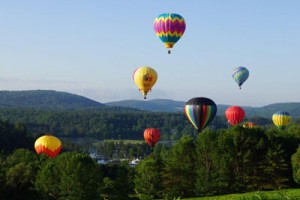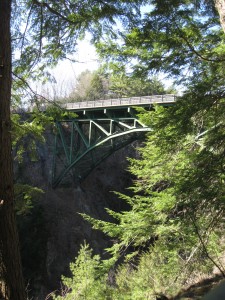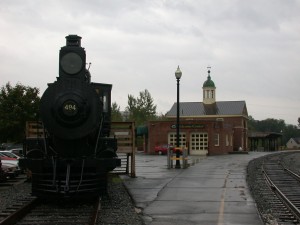Itineraries
Historic Sites
 White River Junction was named for its location as a meeting place of rivers, railroads, and highways. Early travelers by water congregated here at the confluence of the Connecticut River and the White River, where early bridges over the Connecticut (1803) and the White (1815) created crossroads communities. Between 1847 and 1863, five new railroad lines converged on the banks of the two rivers. Today, the Vermont village continues to be the heart of a region where past meets present and where science, the arts, and business come together – at the Junction.
White River Junction was named for its location as a meeting place of rivers, railroads, and highways. Early travelers by water congregated here at the confluence of the Connecticut River and the White River, where early bridges over the Connecticut (1803) and the White (1815) created crossroads communities. Between 1847 and 1863, five new railroad lines converged on the banks of the two rivers. Today, the Vermont village continues to be the heart of a region where past meets present and where science, the arts, and business come together – at the Junction.
White River Junction is a village within the town of Hartford, VT, and is the Waypoint community for the towns of Hartland and Norwich, VT, and Lebanon, Hanover, and Plainfield, NH. Its Waypoint Interpretive Center is located in an historic train station in downtown White River Junction, and also serves as a Vermont Welcome Center.
The designated Byway routes in the White River Junction area are Route 5 in Vermont and in New Hampshire, Route 10 from West Lebanon to points north and Route 12A from West Lebanon to points south.
Nature and Scenery
At White River Junction, the flow of the Connecticut is swelled by the White River, whose own watershed of tributaries reaches deep into central Vermont. The Ottauquechee River enters the Connecticut to the south after its course through Quechee Gorge, one of the geologic wonders of the region. The gorge, cut down through 150 feet of bedrock, is visible from a bridge over Route 4.
The Montshire Museum in Norwich, VT, is a hands-on science museum with dozens of exhibits relating to the natural and physical sciences, technology, and ecology, including the Silvio O. Conte National Fish and Wildlife Refuge. The self-guiding museum is engaging for adults and children of all ages, and is located on a 110-acre site on the Connecticut River with a network of easy-to-moderate walking trails.
The Vermont Institute of Natural Science in Quechee, VT offers year-round educational programs, camps, workshops, events and tours designed to engage people and their communities in the active care of their environment. Its live raptor exhibits are a particular favorite of many return visitors. Together, VINS and the U.S. Fish and Wildlife Service offer programs and exhibits highlighting the array of wildlife and habitats found on the Silvio O. Conte National Fish and Wildlife Refuge and their conservation efforts.
History and Culture
As the crossroads of several railroads and highways, the Town of Hartford developed into several distinct communities, four of which today include historic districts – White River Junction, Hartford Village, Wilder Village, and the Quechee Historic mill district. To the North, Norwich Village historic district is centered on a classic New England green. Across the river in Lebanon, Colburn Park historic district has a more urban feel. Briggs Opera House and the Coolidge Hotel are the cultural core of downtown White River Junction. Dartmouth College and Hanover, NH is one of the premier cultural sites in northern New England. In addition to its libraries and bookstore, it boasts the Hood Museum of Art.
Among Vermont’s historic covered bridges in the area are Martin’s Mill Bridge over Lull’s Brook and the Willard Bridge over the Ottauquechee River, both in Hartland. Covered bridgesin New Hampshire are the Meriden Bridge over Blood Brook in Plainfield, and the Packard Hill Bridge over the Mascoma River in Lebanon.
Recreation
Quechee Gorge runs through Quechee State Park.
Railroads
 White River Junction was a crossroads for five railroads, all constructed between 1847 and 1863. Two lines survive – the Boston and Maine, and the Central Vermont. The B&M built the present large brick passenger station in 1937 in the Colonial Revival style, and Amtrak stops at the station twice a day. Outside the station, which houses a welcome center operated by the state of Vermont and local chambers of commerce, stands a great iron horse, “Old 494,” with its coal car and caboose. This restored locomotive engine hauled passenger cars and light freight up and down the river valley from 1892 to 1938.
White River Junction was a crossroads for five railroads, all constructed between 1847 and 1863. Two lines survive – the Boston and Maine, and the Central Vermont. The B&M built the present large brick passenger station in 1937 in the Colonial Revival style, and Amtrak stops at the station twice a day. Outside the station, which houses a welcome center operated by the state of Vermont and local chambers of commerce, stands a great iron horse, “Old 494,” with its coal car and caboose. This restored locomotive engine hauled passenger cars and light freight up and down the river valley from 1892 to 1938.